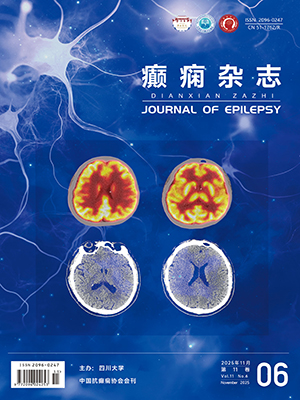| 1. |
Ngugi AK, Bottomley C, Fegan G, et al. Premature mortality in active convulsive epilepsy in rural Kenya: causes and associated factors. Neurology, 2014, 82(7): 582-589.
|
| 2. |
洪震. 癲癇流行病學研究. 中國現代神經疾病雜志, 2014, (11): 919-923.
|
| 3. |
佐桂芳, 孫磊, 劉召英. 護理干預對癲癇患者家屬心理狀態的影響. 齊魯護理雜志, 2012, 18: 118-119.
|
| 4. |
宋秀峰. 癲癇患兒家長的抑郁水平與其癲癇知識知曉度的相關性分析. 中國實用護理雜志, 2012, 28(15): 2.
|
| 5. |
張芳, 李曉萍, 曾慶枝, 等. 病恥感量表現狀. 醫學綜述, 2015, 21(2): 286-288.
|
| 6. |
Stuber J, Meyer I, Link B. Stigma, prejudice, discrimination and health. Soc Sci Med, 2008, 3(67): 351-357.
|
| 7. |
周開顏, 莫玉梅, 趙海燕, 等. 截癱患者回歸社會的護理干預研究. 河北醫學, 2014, 20(10): 1734-1735.
|
| 8. |
石錦娟, 邢博. 病恥感心理護理對抑郁癥患者的康復效果. 護理實踐與研究, 2012, 9(3): 118-119.
|
| 9. |
王婷, 李東升, 宗世琴. 心理干預對武漢市某醫院銀屑病患者病恥感的影響. 醫學與社會, 2015, 28(8): 95-97.
|
| 10. |
李茂生, 鄔志美. 我國重性精神疾病患者病恥感問題及對策分析. 中國醫學倫理學, 2017, 30(3): 383-387.
|
| 11. |
Ak PD, Atakli D, Yuksel B, et al. Stigmatization and social impacts of epilepsy in Turkey. Epilepsy Behav, 2015, (50): 50-54.
|
| 12. |
Kleinman A, Wang WZ, Li SC, et al. The social course of epilepsy: chronic illness as social experience in interior China. Soc Sci Med, 1995, 40(10): 1319-1330.
|
| 13. |
Goffman E. Stigma: notes on the management of spoiled identity. Englewood Cliffs: Prentice Halll, 1963.
|
| 14. |
Weiss MG, Ramakrishna J, Somma D. Health-related stigma: rethinking concepts and interventions. Psychol Health Med, 2006, 11(3): 277-287.
|
| 15. |
Yang LH. Application of mental illness stigma theory to Chinese societies: synthesis and new directions. Singapore Med J, 2007, 48(11): 977-985.
|
| 16. |
張寶山, 俞國良. 污名現象及其心理效應. 心理科學進展, 2007, 15(6): 993-1001.
|
| 17. |
Scambler G. Epilepsy. London: Tavistock, 1989.
|
| 18. |
Jacoby A, Snape D, Baker GA. Epilepsy and social identity: the stigma of a chronic neurological disorder. Lancet Neurol, 2005, 4(3): 171-178.
|
| 19. |
McCagh J, Fisk JE, Baker GA. Epilepsy, psychosocial and cognitive functioning. Epilepsy Res, 2009, 86(1): 1-14.
|
| 20. |
Muhlbauer S. Experience of stigma by families with mentally ill members. J Am Psychiatr Nurses Assoc, 2002, 8(3): 76-83.
|
| 21. |
Guo W, Wu J, Wang W, et al. The stigma of people with epilepsy is demonstrated at the internalized, interpersonal and institutional levels in a specific sociocultural context: findings from an ethnographic study in rural China. Epilepsy Behav, 2012, 25(2): 282-288.
|
| 22. |
Angermeyer MC. The stigma of mental illness from the patients’view-an overview. Psychiatr Prax, 2003, 30(7): 358-366.
|
| 23. |
徐芳芳. 直腸癌永久性腸造口患者病恥感與應對方式、造口適應、生活質量的相關性研究. 合肥: 安徽醫科大學, 碩士學位論文, 2016.
|
| 24. |
沈曉紅, 姜乾金. 醫學應對方式問卷中文版701例測試報告. 中國行為醫學科學, 2000, 9(1): 18-20.
|
| 25. |
徐暉, 李栓榮, 李崢. 精神疾病患者歧視感知狀況及應對方式的研究. 中國全科醫學, 2012, 15(28): 3281-3283.
|
| 26. |
李江嬋, 姚素華, 謝秀東, 等. 認知行為治療對抑郁癥患者病恥感和應對方式的影響研究. 中國全科醫學, 2015, 18(4): 463-465.
|
| 27. |
Cataldo JK, Jahan TM, Voranan L. Pongquan. Lung cancer stigma, depression, and quality of life among ever and never smokers. European Journal of Oncology Nursing, 2012, 16(3): 264-269.
|
| 28. |
Wan X, Wang C, Xu D, et al. Disease stigma and its mediating effect on the 50relationship between symptom severity and quality of life among Community-dwelling women with stress urinary incontinence: a study from a Chinese city. J Clin Nurs, 2014, 23(15-16): 2170-2179.
|
| 29. |
Cinculova A, Prasko J, Kamaradova D, et al. Adherence, self-stigma and discontinuation of pharmacotherapy in patients with anxiety disorderscross-sectional study. Neuro endocrinology letters, 2017, 38(6): 429-426.
|
| 30. |
朱麗. 恢復期精神分裂癥患者病恥感與服藥依從性的相關性. 皖南醫學院學報, 2014, 33(5): 455-458.
|
| 31. |
張紅彩. 精神分裂癥患者的病恥感與服藥依從性關系的研究. 北京: 中國協和醫科大學, 碩士學位論文, 2010.
|
| 32. |
Lee S, Chiu MY, Tsang A, et al. Stigmatizing experience and structural discrimination associated with the treatment of schizophrenia in Hong Kong. Social Science & Medicine, 2006, 62(7): 1685-1696.
|
| 33. |
李婷. 慢性乙型肝炎病毒感染者病恥感現狀與社會支持及自尊的相關研究. 長春: 吉林大學, 碩士學位論文, 2017.
|
| 34. |
李榮, 李廣慶, 閆榮, 等. 宮頸癌患者病恥感現狀及其相關影響因素分析. 現代臨床護理, 2016, 15(4): 1-5.
|
| 35. |
Reese JB, Finan PH, Haythornthwaite JA, et al. Gastrointestinal ostomies and sexual outcomes: a comparison of colorectal cancer patients by ostomy status. Support Care Cancer, 2014, 22(2): 461-468.
|
| 36. |
Danielsen Ak, Soerensen EE, Burcharth K, et al. Impact of a temporary stoma on patients’everyday lives: feelings of uncertainty while waiting for closure of the stoma. Clin Nurse, 2013, 22(9-10): 1343-1352.
|
| 37. |
Bifftu BB, Dachew BA, Tiruneh BT. Perceived stigma and associated factors among people with epilepsy at Gondar University Hospital, Northwest Ethiopia: a cross-sectional institution based study. Afr Health Sci, 2015, 15(4): 1211-1219.
|
| 38. |
Elafros MA, Bowles RP, Atadzhanov M, et al. Reexamining epilepsy-associated stigma: validation of the Stigma Scale of Epilepsy in Zambia. Qual Life Res, 2015, 24(6): 1483-1489.
|
| 39. |
Gzirishvili N, Kasradze S, Lomidze G, et al. Knowledge, attitudes, and stigma towards epilepsy in different walks of life: a study in Georgia. Epilepsy Behav, 2013, 27(2): 315-318.
|
| 40. |
Aydemir N, Kaya B, Yildiz G, et al. Determinants of felt stigma in epilepsy. Epilepsy Behav, 2016, (58): 76-80.
|
| 41. |
張咪. 癲癇患者對癲癇知曉程度及精神共患病與生活質量的研究. 西安: 西安醫學院, 碩士學位論文, 2020.
|
| 42. |
DB, Wright, RH, Busnello, LG, Buratto. Are valence and social avoidance associated with the memory. Acta Psychol, 2012, 141(1): 78-85.
|
| 43. |
Von C, Brener L, Horwitz R. Implicit and explicit internalized stigma Relationship with risky. Addict Behav, 2017, 76: 305.
|
| 44. |
齊玲, 王婧, 楊梅, 等. 自我隱瞞與健康關系研究現況及發展趨勢. 中國社會醫學雜志, 2015, 32(1): 45-47.
|




